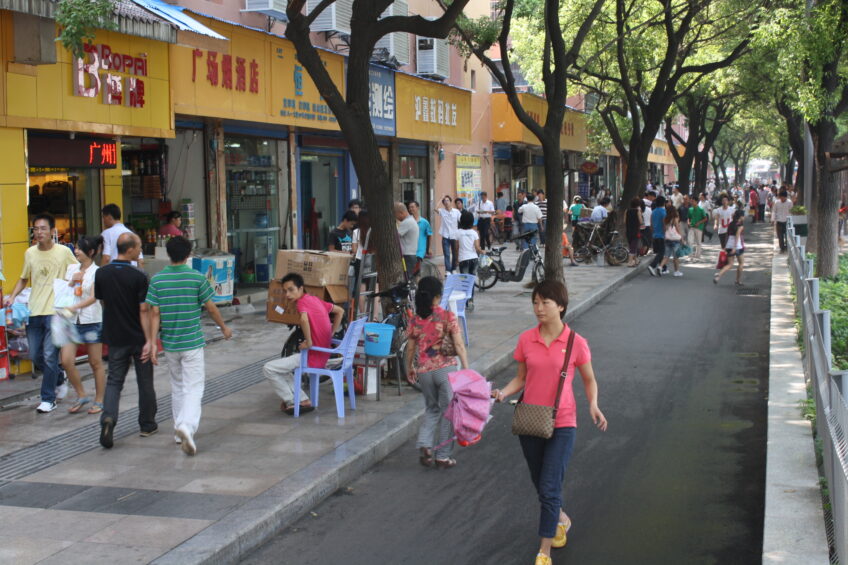China: A booming market… for pork from other countries

China may be booming now for pig production, but will it stay the same in the years to come? How well will China be capable of feeding itself? It will need imports – that is for sure. According to Prof Dr Dermot Hayes, Iowa State University, pig production has huge opportunities in Canada or the USA, in order to keep pork affordable and available in China.
In fact, Prof Hayes’ approach is as logical as it can be. Production will move to places where it will be cheapest to produce. With low supplies of arable grounds available in China, it is expected that prices for feedstuffs and land space will increase so much – that it will pay off to produce pigs there where the corn is grown, for instance in the USA or Canada.
At several international congresses this year, he presented his vision on the future of the Chinese pork market, using mainly tables and production figures. Key in Prof Hayes’ presentation is of course the rapid rate and scale of Chinese development. He names various causes for this rapid rate, e.g. markets forces, entrepreneurship and centralised government; the country’s vastness; a vast movement of labour away from agriculture – a consequence of the one-child policy according to Hayes; unproductive land planted to trees; and high quality land used for development.
The consequences of this rapid rate are ubiquitous in the Chinese landscape. Cities grow at explosive rates with miles of construction sites in every city. And looking at economic figures, this trend does not seem to stop in the foreseeable future.
Comparison between China and USA
Putting things into a refreshing perspective, Prof Hayes created a size and latitude comparison between the United States and China – which can also be seen in Figure 1. In many respects, both countries are similar as they share the latitude (between the Tropic of Cancer and the 50˚ circle of latitude) and size (USA: 9.8 million km2; China: 9.6 million km2).
There are also various big differences – population to name one. The latest population count in the United States led to a total of 311 million souls, whereas China tops this with more than a billion: 1,339 million people are living here. This means, approximately 4.5 times as many people live in China. Agricultural area availability is another difference. The USA has 146 million hectares in crops and 162 million hectares of pasture, which makes a total agricultural area of over 300 million hectares.
In China, on the other hand, the Gobi Desert and the Himalaya in the east virtually reduce its arable surface to about 1/3 of the country’s size – Prof Hayes estimated this to be roughly the same area as the east of the Mississippi river in the United States. With the rapidly growing demand for living space, he calculated available area to have even dropped below 120 million hectares, adding that a lot of this land in China is poor quality land that cannot be mechanised and should not be farmed. And, in this area, more than 650 million pigs live and are slaughtered every year.
In short, Prof Hayes concluded, China has a shortage of available land and has already given up on the most land intensive products, like beef and soybeans. The country is also close to importing corn, he added.
Economic laws including animal feeds
With this new equilibrium about to take place, some economic laws can be introduced, Prof Hayes said. One of these fundamentals shows that once a country starts to import animal feeds, its internal prices rise to reflect world prices plus transportation costs. He added, that experience from Japan shows that it costs as much to move grain from the US to Asia as it costs to produce this grain in the United States. In other words: grain prices double when they have to be shipped across the Pacific.
Taking into account that the Chinese prefer different pork cuts than in the USA or Europe, like e.g. the animal extremes like ears, tongue, snout, feet as well as organs like kidneys or intestines. A complementary trade system may be devised, based on logic and even economics. Shoulder parts are also known to be wanted pork products in China. It would be far more efficient to import boneless boxed cuts in China than to import the bulky grain needed to produce hogs.
Hog production efficiency
An additional advantage of such an alternative trade system may be found in hog production efficiency, which is high in e.g. the United States and Canada. Although changing rapidly as well, the majority of Chinese pig production is still being carried out in backyards. Table 1 gives a clear indication of the situation in 2007 – please note the enormous differences in percentages to express the shares of farm sizes. Bottom line: small, backyard farms, feeding pigs on leftovers from human consumption, still take the vast majority of production.
Commenting on the use of backyard farms, Prof Hayes said that with 9-11% economic growth, the Chinese economy has better things to do with labour than raise pigs on household waste. He said that this system requires labour, small slaughterhouses, wet markets and a willingness to buy non-standardised product. Backyard pig production disappears quickly once households can afford a car to drive to the grocery store and to find employment – a development currently taking place in China at a very high pace.
In addition, current mortality in Chinese pork production is reported to be very high due to disease, e.g. see also the article on Highly Pathogenic PRRS, also known has Porcine High Fever Disease (PHFD). Diseases, being endemic, lead to an overuse of antibiotics and residues as well. In short, both efficiency and food safety are not helped. On top of that, it goes without saying that any animal health policy is doomed when so many backyard hogs are kept in such a small area like in China.
Pork production cost difference
Hayes went on to say that ‘US pork would flood into China’ when only cost prices were to be paid. He indicated that due to lower feed prices in the US, due to relative abundance, and due to efficiency in production, US can produce pork for 56% of the price needed in China. An additional carcass price rise due to shipping can thus be compensated. Unfortunately, for US pork producers, China does also apply import tariffs and Value Added Tax (VAT). This is why, total extra costs add up to 58%, making US pork more expensive than Chinese produced pork.
In addition, importing US pork into China requires care since China has banned the use of the beta agonist ractopamine in pig production since 2002. Hence, any pork in which ractopamine residues are found can be refused. An official trade ban of pork from various US origins followed the discovery of US-produced pork containing ractopamine residues in July 2007. This issue has kept various US cuts and processed products out of the legal channels.
Chinese official policy is aimed at improving the level of Chinese hog production, as could be seen in the article about Agfeed. There is wonder, however, if the construction of new hog units can keep up with the rapid reduction in backyard units. According to Hayes, a scarcity in hog products will occur by the end of 2011 at the latest, which will lead to a stronger growth of a ‘grey’ circuit, in which foreign pork cuts will be repacked before being sold.
Opening up the pork market for competition
Things will not stay this way, Prof Hayes predicted. “A currency appreciation or a solution to the ractopamine issue, or a removal of the differential VAT or import duty would generate large movements of shoulders and inexpensive processed meats.”
He introduced several figures for other countries, like Australia, Japan, South Korea and Mexico – where imports also have started rising rapidly. For China, this future is also going to happen, he said. “China will face food price inflation and high food prices unless it imports.” Prof Hayes continued to say: “It is in China’s best interests to open its food market for competition – and the Chinese government will understand this eventually.”
There will be opportunities for countries that do have access to lower priced grains, like the USA or Canada, he said. “Imported quantities in China will be enormous. Take your best market and multiply by ten.”











